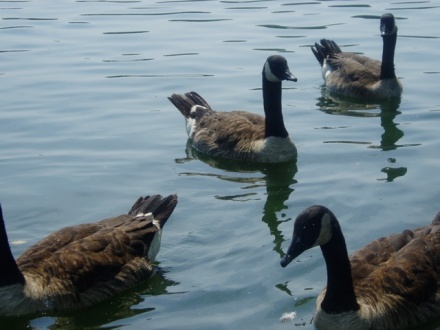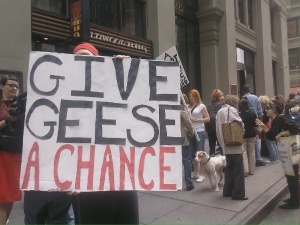It’s now one week since the rounding up, killing and gassing of the beloved Prospect Park geese, a fact that seems more astounding as time goes by. Why did Prospect Park administrators and NYC Parks Department officials sign off on the murder of the entire flock of 400 of the park’s resident geese? It’s still unknown how much discussion was involved or who exactly gave the final approval – was it the Prospect Park Alliance – the conservancy that oversees the park? The city parks department? Mayor Michael Bloomberg himself? Why wasn’t the public notified? A federal agency, the U.S. Department of Agriculture, conducted the raid on the geese under cover of darkness in the middle of the night — no doubt to avoid any “YouTube moments” — with no public notification. The geese were then gassed in an unnamed nearby building. Curious to know what building has been set up to serve as a gas chamber in Prospect Park or the immediate area? And what agency runs it? Did they produce an environmental impact statement?
The New York Times reported that the City’s Parks Department “signed permission for the removal of the birds” and U.S. Department of Agriculture spokesperson Carol Bannerman told the Associated Press in late June, “We can only go onto properties where we have permission.” So who gave permission and how did they arrive at that decision?
Clearly, bureaucracy comes into play between city, state and federal agencies but the New York City Parks Department could have said NO. They had a strong argument for doing so. And, in fact, others have. Dana Rubenstein from the New York Observer reported on July 13th:
In early June, Dave Avrin, the director of Gateway National Park in Queens, earned himself an angry editorial in the Daily News when he, unlike the city, resisted the federal government’s efforts to cull the geese who live in his park.
“Our mission is to protect and preserve wildlife—that’s a law—and it isn’t a given that the removal of the geese is necessary to protect the flying public,” Mr. Avrin told the AP. This, even though the park is much closer to JFK Airport than Prospect Park.
Last year, I attended protests outside the Port Authority (which controls the air space) and City Hall advocating on behalf of the geese and against the killing. I handed out flyers with many others and spoke to people passing by. We knew then, as NYC Audubon has now stated, that this mass killing is “not supported by sound science,” that there are always alternatives.
This is being done more for p.r. than air safety.
After gloating about this issue last year (claiming that the geese are just “going to sleep” and “having sweet dreams”), this year, Mayor Bloomberg was curiously quiet, no doubt to avoid the scores of protesters who last year showed up outside his home to protest.
These geese lived mainly between Prospect Park and nearby Green-Wood Cemetery – they were rounded up while they were moulting, feet bound, and taken from their their mates and goslings, and gassed in a nearby Park building. All under the direction of the USDA in a continuation of last year’s misguided policy of rounding up and killing geese within a 5 mile radius of the two main New York City airports. This year the radius of roundup was increased to 7 miles; officials concluded that this 2 mile increase was to now include Prospect Park. But many of the geese that were killed throughout the city were resident that did not fly into airline pathways. As Mitchel Cohen wrote, the killing of these geese, our friends, was “just a ruse and accomplishes nothing.”
Does this policy even makes sense? Is it effective? Are there no alternatives? And why was it kept from the public, as former New York City Parks Commissioner Henry Stern asks on his blog.
I wrote a bit about my own personal experience with the Prospect Park geese on my LUMA blog here.
Dana Rubenstein continues:
The geese culling frenzy stems, of course, from the January 15 crash landing of a U.S. Airways flight in the Hudson River after geese were sucked into the plane’s engines. Remember? This was the Miracle on the Hudson, in which no one died. According to the same AP article, which cited FAA stats, between 1990 and 2008, there were just 11 civilian deaths resulting from about 1,200 bird-plane collisions in the U.S., but the guilty birds were “not necessarily geese.”
Far more airline-related deaths are caused by the intense working conditions of the Air Traffic Controllers and pilots, and the breaking of their unions, which have allowed the government to increase their workload and dangerously shorten response times. The whole “kill the birds if they get in our way” policy by NYC Parks Department officials is especially ironic as we are inundated with pictures of thousands of people trying desperately to save birds in the Gulf of Mexico. And so it goes.
– Cathryn Swan
[Residents, Park-goers, Wildlife Advocates are holding a Vigil for the Prospect Park Geese, Saturday, July 17th, 6:30 p.m. near the Prospect Park Lake, Southwest side of the park, enter at Vanderbilt Street or the Park Circle. F train to Fort Hamilton Parkway stop – exit towards Prospect Avenue/Reeve Place. Everyone is invited.]
top photo: Cathryn
bottom photo: Jennifer Dudley




